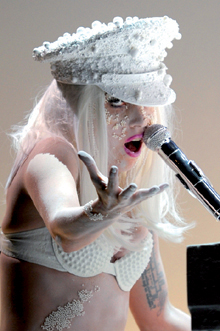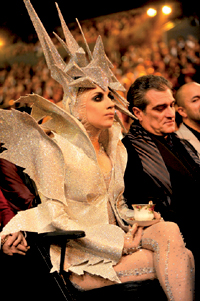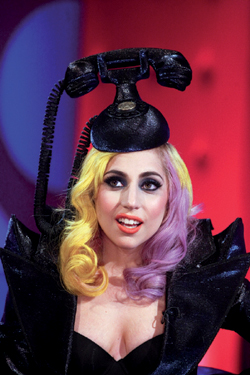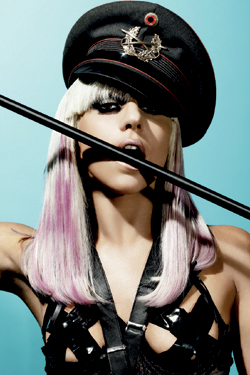Poker Face (14 page)
Authors: Maureen Callahan


A pearl-encrusted Gaga performs at amfAR’s New York Gala at Cipriani 42nd Street to mark the beginning of Fashion Week, February 2010.
Larry Busacca/Getty Images

Working her skyscraper chic with her favorite accessory, her pink teacup, at the 52nd Annual Grammy Awards, January 2010.
Kevin Mazur/WireImage

The telephone hat must have seemed the only logical follow-up to the mechanical dress: Gaga after her performance on the same broadcast of
Friday Night with Jonathan Ross,
March 2010.
Brian J. Ritchie/Hotsauce/Rex/Rex USA

Channeling Charlotte Rampling in
The Night Porter,
a 1974 curio about a former concentration camp victim who, years later, falls in love with her Nazi tormentor. For some reason, fashion people love this movie.
Rennio Maifredi/trunkarchive.com, 2009
B
ack to May 2009 and back to L.A., where
Gaga appeared on
The Ellen DeGeneres Show
in her now-famous rotating orbital headpiece. “It’s my barrier,” she told Ellen. “It’s my Gaga barrier.” Then she performed “Poker Face,” starting it off as a lounge lizard/cabaret number before going into full-on dance mode, spheres spinning. The same day she had a shoot with
Rolling Stone
magazine from five-thirty
P.M.
to midnight, for the cover of their annual “Hot Issue,” to be shot by famed photographer David LaChapelle, and then she had a live performance the next night, May 12, on
Dancing with the Stars.
The following night, she was on a plane to Australia to rejoin the Pussycat Dolls on tour. By now she was the only act on the bill anyone was talking about.
“We’d go into catering and there’d be the local papers and reviews, and the leads would say, ‘Gaga dominated,’ ” says Ciemny. “And the Dolls were sitting right there. It was embarrassing.”
Lead Pussycat Doll Scherzinger says she’d study Gaga from the side of the stage every night. “I remember watching her perform, her eyes,” Scherzinger says. “I looked at her and said, ‘I’m afraid of her.’ As an artist, there are things I want to be fearless enough to communicate, but I limit myself sometimes. She had no boundaries, no fear, and did it in such a creative, theatrical way, she inspired me to be like, ‘Wow, you can do this.’ She’s got so many costumes, so many new ideas, the most amazing art creations on her head.”
As for whether the other Dolls felt upstaged, as had been reported, Scherzinger says, “I don’t think they felt that. I think they thought she was a force to be reckoned with.”
“It was a little awkward,” says David Ciemny. “There was a closed-door situation for a little bit.”
At the time, Gaga had been dating a guy who went by the name Speedy (real name: Frank Lopera). She and Williams had broken up, and Williams had rekindled his relationship with Erin Hirsh. What exactly Speedy did for a living remained unclear: He’s alternately been described as a male model, an artist, and an energy drink entrepreneur. He was mentioned in the
Rolling Stone
article as a supporting character, along with Lüc, whom she described as her great lost love: “I was his Sandy, and he was my Danny, and I just broke,” she told the magazine. She also went on a bit about being bisexual, but how she didn’t really want to go on about being bisexual because that would be exploitative.
The stuff about Lüc was telling; she’d broken up with him that past December, but anyone who was close to her knew she wasn’t over him.
“I don’t think she’ll ever be over Lüc, you know?” says Angela Ciemny. David agrees: “She just has always had a thing for him that is beyond . . . and he knows it and he took advantage of it.” Later that year, in November, Lüc showed up for Gaga’s record release party at the now-defunct Virgin megastore in Manhattan’s Union Square. “I would equate it to a drug,” David says. “I mean, I talked to her for hours and hours about him. He came down to Virgin megastore and there’s hundreds of kids all lined up, and all she could think about is ‘Lüc’s coming, oh my God, Lüc’s coming.’ No matter what she was doing, or what guy she was with, when she went to New York, she was pretty much going to be with Lüc.”
He also showed up, long after their breakup, at her record release party at the Highline Ballroom in New York City, where, according to a source, he proceeded to talk about how she was lip-syncing too much and how he was trying to make her stop it. No one understood what she saw in this guy; as Brendan Sullivan puts it, “Lüc. Fucking Lüc.”
Back to Speedy: “She seemed really gaga over him,” says Scherzinger, seemingly unaware of the pun. “I remember her talking about going away on vacation with him.” (The two were shot on the beach in Hawaii in June, and these were the first U.S. paparazzi shots of Lady Gaga, since she had become Lady Gaga, without any makeup on. She’s wearing a black one-piece bathing suit and flip-flops; her eyebrows are dyed blond; and her real hair is damaged and coarse. Curiously, she seems to be aware of the photographers; in one shot, she’s making direct eye contact with the camera.)
“Speedy was a friend of [photographer] David LaChapelle,” says a source. “And David LaChapelle—Gaga put that guy on the highest pedestal ever, because of his art. Speedy . . . I don’t know what that guy does. He would come out on the road and it was like, ‘What are you working on?’ and he’d be like, ‘Uh . . .’ The guy was all talk. But his thing was, he was really well-endowed. That’s all she talked about. I would tell her, ‘TMI’ [too much information] all day long.”
Amanda Lepore, the famous New York City transsexual icon and nightlife fixture, met Speedy and Gaga through her friend LaChapelle (she has been called his muse). She is also friendly with the rapper Cazwell, who produced parts of Lepore’s first record (sample title: “My Hair Looks Fierce”). Actually, she says, she’d known Speedy from the nightlife scene since he was about fifteen and working as a club promoter at a gay night called Beige at downtown’s Bowery Bar.
LaChapelle invited Lepore and Cazwell to his office in New York for his meeting with Gaga about concepts for her
Rolling Stone
shoot. Gaga then invited all of them to dinner at Speedy’s parents’ house in Queens.
“She was super-nice and down-to-earth,” Lepore says. Gaga was still in that day’s makeup, but was wearing leggings and flats. “She was talking about Lady Gaga in the third person, like, ‘Oh, Gaga would do this,’ ‘Gaga that.’ But not like it was her—like it was a third person. I think she’s really crossed that boundary.”
Gaga had also invited several of her old friends along, and Lepore remembers thinking how interesting it was that she wasn’t running with a fabulous New York crowd: “They were very, like,
Jersey Shore,
” she says, “with the fake tans . . . One of the boyfriends had, like, tweezed eyebrows and shaved body hair.”
Most shocking, says Lepore, was that Gaga cooked dinner for the whole group: spaghetti. It surprised them all but was very much in keeping with the Catholic girl from the nice Italian family on the Upper West Side, who says that a part of her really wants to find a nice man to marry and serve him dinner each night. When Angela and David Ciemny visited Gaga at her new home in L.A. in October 2009, she ushered them into the kitchen, where she was making dinner for Matt Williams; they’d been back together for nearly a year. She was in high heels, tight pants, and a black bra.
In Australia, Gaga’s profile was rising; “LoveGame,” released
as a single there, had hit nineteen on the charts in April, and her video had been banned, in part because she wasn’t wearing any pants. (What seemed outré back when the video was shot was, by the summer of 2009, a full-on urban trend; in New York City, girls took to wearing belted Oxford shirts, shoes, and nothing else—to work.) In mid-May Gaga appeared on the Australian talk show
Rove
wearing a simple white V-neck dress and an eighteen-inch pyramid of braided hair atop her head. She looked like one of the
SNL
Coneheads.
Her speaking voice had lost its New York outer-borough roughness; she was speaking in that higher, far more girlish pitch, regional accent buffed and puffed away, network news anchor–style. She had also begun to perfect the art of seeming remarkably humble while actually congratulating herself:
“Since we last had you on the show,” says host Rove McManus, “you haven’t stopped touring, and it’s been nearly twelve months.”
“It’s been exactly twelve months, I think,” Gaga replies.
“How’s it all been for you?” Rove asks.
“It’s been really amazing. I just am so grateful and I can’t believe it. I just played in New Zealand yesterday and”—she takes a breath—“twelve thousand people are singing my lyrics.”
She also appeared on
Sunrise,
Australia’s equivalent of
The Today Show,
and caught a lot of flak in the press for lip-synching. Ciemny says it was not unlike the disparagement suffered by Ashlee Simpson when she was caught lip-synching on
Saturday Night Live.
“Australia does not, will not, tolerate track acts,” he says. “It just won’t do it.” Gaga, he says, had played a gig the night before, gotten just three hours of rest, and woke up to almost no voice.
She was suffering from lack of sleep, perpetual jet lag, and a rigorous, self-imposed diet. “She’d say, ‘I can’t have that, I can’t have that,’ ” David Ciemny says. “She always wanted salads, deli meat and cheese, and hummus and chicken—that was her big thing, hummus and grilled chicken. If she had something fried, she’d say, ‘I totally splurged.’ ”
Like just about every other famous young girl, Gaga had to keep her weight at a ridiculously low level. “From the first time we met her and measured her and checked her for the final [ensembles], she’d lost twenty pounds,” says a costumer who worked with her last year. “She self-proclaimed that she didn’t eat for weeks to fit into the clothes.”
Her schedule had, if possible, gotten more intense. Or maybe it just felt that way. Ciemny says that, during his time with her, he had to take her to the hospital at least half a dozen times in various countries; sometimes people would tell her she had to go, sometimes she would call from her room and say she needed to go.
“Her promotion schedule was ridiculous,” says David Ciemny. “When I say she was sick, I mean physically and mentally. It was all exhaustion from lack of sleep, too many shows. There was this point of breaking down in tears, just so exhausted. The doctor would say, ‘You need three days with nothing but sleep; cancel everything.’ And we’d cancel everything. For twelve hours.”
“She was just completely depleted,” says David’s wife Angela. “You know, I would call David and say, ‘You need to call her manager and tell him she can’t perform, or she can’t get up at five in the morning.’ And it would always be like, ‘Ange, get her to do it. Get her to eat, get her to sleep right now, she doesn’t need to take her makeup off, she doesn’t need to shower.’ ” Angela thinks Gaga’s only escape was the hospital: “I think these were times when it was, like, ‘I can’t be pushed. I need to check out.’ ”
The usual course of treatment, David says, was an IV bag filled with saline and electrolytes and a B-12 shot for energy. On those rare occasions that he called Gaga’s parents to let them know their daughter was in the hospital, he’d catch it from her management.
“The parents would call the manager saying, ‘Why are you letting there be a schedule like this for my daughter? Are you crazy? What are you thinking?’ And then management would call me and say, ‘What are you thinking? Why would you call the parents and make them all worried?’ ”
After the Pussycat Dolls tour, Gaga was off to Asia to do
promotion from June 1 to 13; on June 26, she embarked on a two-month-long tour of Europe. In between, she went on that vacation she’d been telling Scherzinger about, with her boyfriend Speedy. They stayed at David LaChapelle’s house. It was here that she finally heard back from Kanye West about an idea for the two to co-headline a tour later that year.
West flew down to Hawaii the next day, and LaChappelle photographed them for the tour, a Tarzan-and-Jane theme. “The whole Kanye tour . . . a lot of people [on her team] thought it was a bad idea,” says David Ciemny. “Because Kanye’s a disaster; he’s just a mess. We all knew it was a train wreck waiting to happen. And actually it was Anthony Randall, her production guy, who basically said, ‘Really, if you’re doing Kanye, I’m out, I’m done.’ She didn’t care. Their relationship went downhill really quickly. He didn’t last very long.”
West and Gaga announced tour dates for their co-headlining “Fame Kills” tour on September 15, 2009. “I saw the concept book for it,” says a Kanye source. “It was a really complicated, high-concept collaboration—it wasn’t like, opening act/main act. It was this whole intricate, creative, never-before-seen kind of thing, with a lot of duets and a few new songs, this elaborate stage . . . it seemed intense, a lot for a new artist that’s blowing up at that second to go off and do this other thing.”
On October 1, the tour was canceled. The causal link was assumed to be West’s hijacking of teenage newcomer Taylor Swift’s VMA acceptance speech for Best Female Video, proclaiming that Beyoncé deserved it. But that, according to sources, was only part of it, and good timing for a classy bow out; he was public enemy number one, his record sales tanked, Donald Trump called for a Kanye boycott. . . . Gaga, meanwhile, was becoming increasingly famous, morphing from an object of curiosity and fascination to a star who was well liked in the industry and who was generating an increasingly rabid fan base.
“I know there was creative infighting before [they canceled the tour]; he told me that,” says the Kanye source, adding that Gaga and West also had a “strained” personal relationship. “But someone else who’d worked with him told me that if it hadn’t been the VMAs thing, it would’ve been something else, because he was just trying to get the whole thing shut down. It was just some fucked-up way of trying to get off the road.”
“That turned out to be a good thing for her,” says Gary Bongiovanni, editor in chief of the trade publication
Pollstar
. “You kind of got the sense that she was driving that tour; now she’s going on, headlining, and she is the star of the show.” (According to
Pollstar,
from October 8, 2008, through March 14, 2010, Lady Gaga grossed $12.8 million on tour.)
That summer, she was booked into two of England’s biggest festivals: Glastonbury and T in the Park. Glastonbury was especially telling: Here she was, playing an outdoor festival in the daytime just two years after she’d had such a disastrous experience at Lollapalooza. She did five costume changes over an hour-long set, including a space-age disco minidress (a look she’d directly ripped off from Missing Persons’ Dale Bozzio). She had three male dancers behind her. The choreography was tight; she had a new backing band; she was performing before a sea of people, fifty thousand in all, girls with lightning bolts painted over one eye in tribute to her.